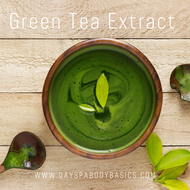Green Tea Extract- Ingredient Highlight
Posted by Kelsey Johnson on 23rd May 2021
Green tea comes from the plant Camellia Sinensis. Camellia Sinensis is part of the evergreen family. The leaves are glossy green with serrated edges. When allowed to flower, the plant produces small white flowers with bright yellow stamens. The fruit that develops has a hard green shell and a single, round, brown seed. The seeds can be used to make tea oil.

ALL tea originates from the Camellia Sinensis plant, whether its black tea, green tea, or oolong tea. The difference is how they are all processed. There are different types of green tea grown and produced all over the world today, including China, Japan, India, Sri Lanka, Taiwan, Bangladesh, New Zealand, Hawaii and even South Carolina. Green tea, however, is considered to have originated in China. It is said that even today the word “tea” in China refers only to green tea. China’s Yunnan province is considered to be the original home of the Camellia Sinensis plant species.
One popular legend suggests that Shennong, Emperor of China and supposed inventor of Chinese medicine, discovered tea as a beverage around 2737 B.C when fresh tea leaves from a nearby tea tree fell into his cup of just boiled water. Emperor Shennong found the flavor incredibly refreshing and thus, a new beverage was created. Green tea was primarily available to the highest tiers of Chinese society and was very expensive to purchase. It was not until the 14th century that green tea became accessible to the general public for enjoyment and medicinal purposes.

In the last few decades, the popularity of green tea has steadily increased. In addition to its versatile flavors, many health discoveries are taking place due to its high number of antioxidants. It appears that the more we learn about this amazing tea, the more impressive and beneficial it becomes.

Green tea extract is a supplement derived from the green tea plant. It contains concentrated compounds of antioxidants, polyphenols, vitamins and flavonoids of green tea. These have been credited with a range of health benefits, from promoting heart, liver and brain health to improving your skin and even reducing the risk of cancer.
Health Benefits Of Green Tea Extract
The health benefits of green tea extract are mostly due to its high antioxidant content. Green tea extract boosts antioxidant capacity, which may help prevent various health problems caused by oxidative stress.
When applied to the skin, green tea extract can help treat a variety of skin problems such as: skin aging, acne, loss of skin elasticity, inflammation and cancer caused by exposure to UV rays.
Increases Moisture
Green tea extract contains polyphenols, such as ECGC, which are known to be effective in protecting against free radicals which may ultimately damage the skin. The extract helps the skin to retain moisture and hydration, restoring overall skin tone.
Reduces Puffiness
Green tea extract and tea bags naturally contain some caffeine, a known vasoconstrictor, which can help reduce puffiness of dark circles and bloating of the face when applied topically. Paired with green tea EGCG’s anti-inflammatory properties, green tea extract is an extremely effective way to reduce swelling and redness of the skin, especially around puffy eyes.
Fights Acne
Sebum production, the oil naturally secreted from the skin’s glands, is a key factor in developing oily skin and acne breakouts as it can clog the pores with dirt and oil. The EGCG in Green tea has been shown to reduce sebum production, which in turn helps to alleviate the development of acne. Green tea extract also has antibacterial properties that can help treat active acne breakouts, making it a powerful acne treatment ingredient.
Matcha Green Tea
Now that we have discussed the general skin benefits of green tea, we would like to talk a little bit about matcha green tea and its benefits. We use matcha green tea powder and matcha green tea oil in a couple of our skincare products.
Like green tea, matcha comes from the Camellia Sinensis plant. However, it’s grown differently and has a unique nutrient profile. Farmers grow matcha by covering their tea plants 20–30 days before harvest to avoid direct sunlight. This increases chlorophyll production, boosts the amino acid content, and gives the plant a darker green hue.

Once the tea leaves are harvested, the stems and veins are removed and the leaves are ground up into a fine powder known as matcha. Matcha contains the nutrients from the entire tea leaf, which results in a greater amount of caffeine and antioxidants typically found in green tea.
Achieve a bright and radiant looking complexion with our Matcha Green Tea Botanical Cleansing Powder. It contains luxurious botanicals and grains and can be mixed with water or our Matcha Green Tea Cleanser to create a customized, gentle exfoliator. Rice powder absorbs oil while salicylic acid and flower pulp remove dead skin cells. This is a great way to infuse your skin with healing antioxidants.

If you enjoyed reading this blog, check out our other “Ingredient Highlight” blogs. It can be fun and beneficial to learn about the many healing ingredients that can be found in nature! Feel free to follow us on Pinterest, Instagram and Facebook so you can stay updated on new products, promotions and fun facts.
